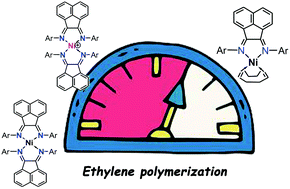Nickel complexes based on BIAN ligands: transformation and catalysis on ethylene polymerization†
Abstract
Treatment of bis(arylimino)acenaphthene (ArBIAN) with Ni(COD)2 in toluene afforded dmpBIANNi(COD) (2a, dmp = 2,6-Me2C6H3) and dippBIANNi(COD) (2b, dipp = 2,6-iPrC6H3), respectively, in moderate yields. Complexes 2a and 2b can be oxidized by a small amount of oxygen at low temperature leading to oxygen-bridged dinuclear Ni(II) complexes (dmpBIANNi)2(μ-O)2 (4a) and (dippBIANNi)2(μ-O)2 (4b), respectively, as a purple powder. The reaction of ArBIAN with 0.5 equiv of Ni(COD)2 or Ni(Ph3P)4 gave bisligated complexes (dmpBIAN)2Ni (3a) and (dippBIAN)2Ni (3b), which can be considered as Ni(0) complexes supported by two neutral BIAN ligands. Oxidation of the bisligated nickel complexes 3a and 3b with [Cp2Fe][B(C6F5)4] afforded cationic Ni(I) complexes [(dmpBIAN)2Ni][B(C6F5)4] (5a) and [(dippBIAN)2Ni][B(C6F5)4] (5b), respectively, in which the Ni(I) centre is chelated by two neutral Ar-BIAN ligands. These complexes were characterized by NMR and IR spectroscopy and DFT calculation, and the molecular structures of 3b, 4b, and 5b were well established by X-ray diffraction analysis. These complexes were evaluated as catalysts for ethylene polymerization in which 2b showed high activity in the presence of AlMe3. 13C NMR analysis of polymers showed that the 2b/AlMe3 catalytic system gave less-branched polymers when compared to that obtained with dippBIANNiBr2 under the same conditions.



 Please wait while we load your content...
Please wait while we load your content...